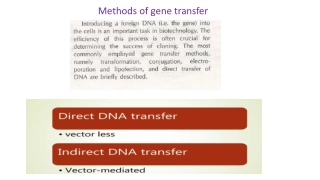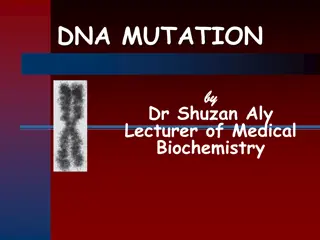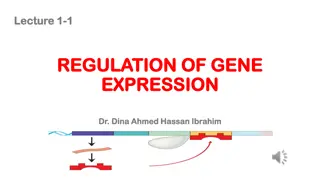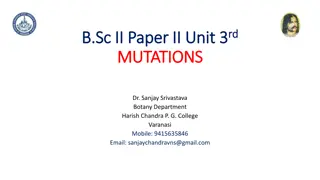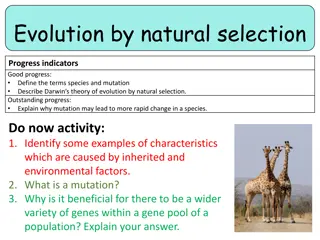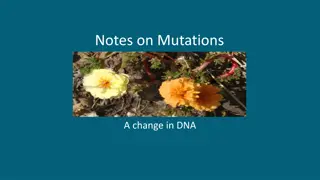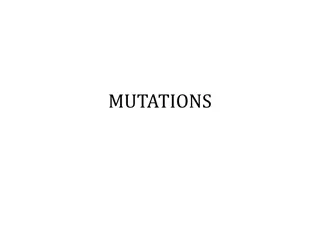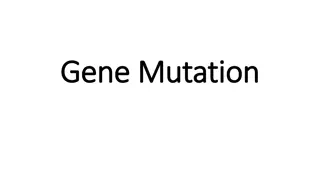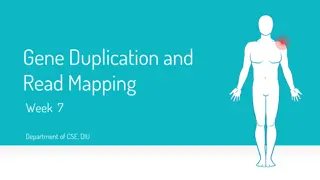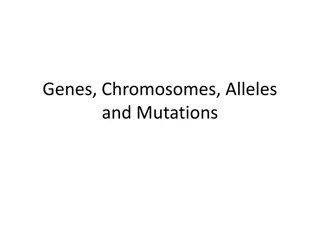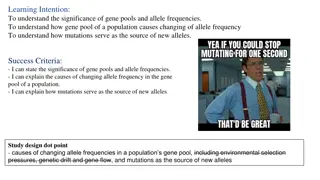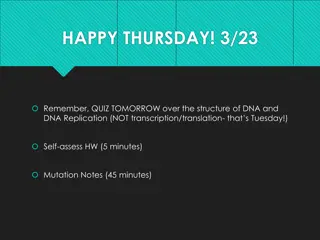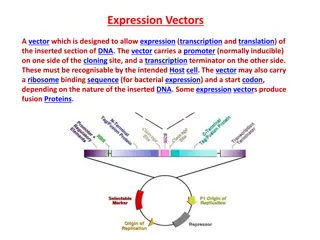Understanding Gene Mutations in Molecular Biology
Gene mutations play a significant role in molecular biology, leading to alterations in DNA sequences that can impact offspring. These mutations can arise spontaneously or be induced by various factors, such as mutagens. Understanding gene mutations is crucial for comprehending the genetic basis of cellular functionalities and dysfunctions. Bacterial genes, organized in operons, can undergo mutations with diverse consequences like changes in structural characteristics or antibiotic sensitivity. Gene mutations give rise to different mutant types, such as auxotrophs, resistant mutants, and regulatory disruptions. By studying gene mutations, researchers uncover insights into the molecular mechanisms underlying genetic variability.
Download Presentation

Please find below an Image/Link to download the presentation.
The content on the website is provided AS IS for your information and personal use only. It may not be sold, licensed, or shared on other websites without obtaining consent from the author. Download presentation by click this link. If you encounter any issues during the download, it is possible that the publisher has removed the file from their server.
E N D
Presentation Transcript
Molecular Biology lecture 4 Asst. Prof. Dr. Dalya Basil Hanna
In this lecture.. Mutation: Gene (point) Mutation Chromosomal Mutation
Gene Mutation A gene mutation occurs when the nucleotide sequence of the DNA is altered and a new sequence is passed on to the offspring. The change may be either a substitution of one or a few nucleotides for others or an insertion or deletion of one or a few pairs of nucleotides.
Gene Mutation Genomes of bacteria exist on a single double-stranded circular DNA molecule that contains approximately 4000 kb of DNA and are regulated by operons, the majority of bacterial genes exist on one circular chromosome, there are other genetic elements within the bacterial genome. A mutation is a change in the nucleotide sequence and can create new cellular functionalities dysfunction of others. Mutations can occur spontaneously or be caused by exposure to mutation-inducing agents. or lead to the
Gene Mutation A spontaneous mutation is one that occurs as a result of natural processes in cells, for example DNA replication errors. These can be mutations; those that occur as a result of interaction of DNA with an outside agent or mutagen that causes DNA damage. Mutagens may be of physical, chemical, or of biological origin. Mostly they act on the DNA directly, causing damage which may replication. Although, severely damaged DNA can prevent replication and cause cell death. distinguished from induced result in errors during
Gene Mutation Bacterial genes with similar functions often share one promoter (RNA polymerase transcribed simultaneously; this system is called an operon. Typical operons consist of several structural genes that code for the enzymes required for the pathway. Regulation occurs through transcription factors binding to a short sequence of DNA between the promoter region and the structural genes called an operator binding site) and are
Gene Mutation Results of mutations can produce changes in structural or colony characteristics or loss in sensitivity to antibiotics. Some potential consequences of mutations are as follows: Auxotrophs: have a mutation which leaves an essential nutrient process dysfunctional. Resistant mutants: can withstand the stress of exposure to inhibitory molecules or antibiotics secondary to acquired mutation. mutants: have sequences like promotor regions. Regulatory disruptions on regulatory Constitutive mutants: continuously express genes that usually switch on and off as in operons.
Gene Mutation Mutation rates have been measured in a great variety of organisms, mostly for mutants that exhibit visible and prominant effects. Mutation rates are generally lower in bacteria and other microorganisms than in more complex species. In humans and other multicellular organisms, the rate typically ranges from about 1 per 100,000 to 1 per 1,000,000 gametes. There is, however, considerable variation from gene to gene as well as from organism to organism.
Gene Mutation Mutations are of fundamental importance in molecular biology for several reasons: 1- Mutations are important as the major source of genetic variation that drives evolutionary change. 2- Mutations may have deleterious or (rarely) advantageous consequences to an organism. 3- Mutant organisms are important tools for molecular biologists in characterizing the genes involved in cellular processes.
Gene Mutation At the molecular level, in eukaryotes and prokaryotes the simplest type of mutation is a nucleotide substitution, in which a nucleotide pair in a DNA duplex is replaced with a different nucleotide pair. Mutations that alter a single nucleotide pair are called point mutations. Other kinds of mutations cause more drastic changes in DNA, such as expansions extensive insertions and chromosomal rearrangements. of trinucleotide deletions, repeats, major and
Gene Mutation Other kinds of mutations cause more drastic changes in DNA, such as expansions extensive insertions and chromosomal rearrangements. of trinucleotide deletions, repeats, major and
Gene (Point) Mutation Transitions and transversions can lead to: 1- silent mutation 2- missense mutation 3- nonsense mutation
Silent mutations Nucleotide substitutions in a protein-coding gene may or may not change the amino acid in the encoded protein. Mutations that change the nucleotide sequence without changing the amino acid sequence are called synonymous mutations or silent mutations. Mutational changes in nucleotides that are outside of coding regions can also be silent. However, some noncoding sequences do have essential functions in gene regulation and, in this case, mutations in these sequences would have phenotypic effects.
Missense mutations Nucleotide substitutions in protein-coding regions that do result in changed amino acids are called missense mutations or nonsynonymous mutations. type of mutation base pair that results in the substitution of one amino acid for another in the protein made by a gene. This is a change in one DNA A change in the amino acid sequence of a protein may alter the biological properties of the protein.
Nonsense mutations A nucleotide substitution that creates a new stop codon is called a nonsense mutation. Because nonsense mutations cause premature chain synthesis, the remaining polypeptide fragment is nearly always nonfunctional. termination during protein A nonsense mutation is also a change in one DNA base pair. Instead of substituting one amino acid for another, however, the altered DNA sequence prematurely signals the cell to stop building a protein. This type of mutation results in a shortened improperly or not at all. protein that may function
Chromosomal mutation Chromosomes, which carry the hereditary material, or DNA, are contained in Chromosomes come in pairs, with one member of each pair inherited from each parent. The two members of a pair are called homologous chromosomes. Each cell of an organism and all individuals of the same species have, as a rule, the same number of chromosomes. the nucleus of each cell.
Chromosomal mutation Changes chromosomes within a species are termed chromosomal mutations, chromosomal chromosomal aberrations. Changes in number may occur by the fusion of two chromosomes into one, by fission of one chromosome into two, or by addition or subtraction of one or more whole chromosomes or sets of chromosomes. in the number, size, or organization of abnormalities, or
Chromosomal mutation Changes in the structure of chromosomes may occur by inversion, when a chromosomal segment rotates 180 degrees within the same location; by duplication, when a segment is added; by deletion, when a segment is lost; or by translocation, when a segment changes from one location to another in chromosome. These are chromosomes evolve. Inversions, translocations, fusions, and fissions do not change the amount of DNA. The importance of these mutations in evolution is that they change the linkage relationships between genes. Genes that were closely linked to each other become separated and vice versa; this can affect their expression because genes are often transcribed sequentially, two or more at a time. the the same processes or a different by which


